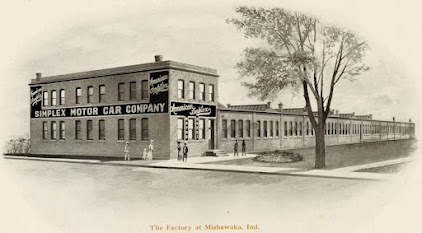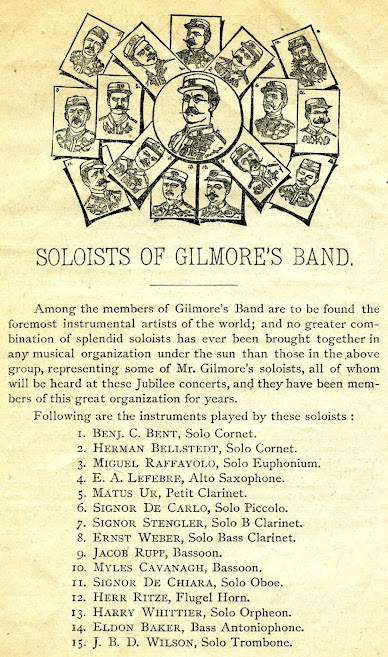Almost 20 years before Route 66 was completed, which "winds from Chicago to L. A.," and almost 40 years before that highway was memorialized in the hit song that began, "If you ever plan to motor west," C. G. Conn did indeed "motor west." However, he used the rough roads that would eventually become Interstate 80, winding from his hometown of Elkhart, Indiana to the Pacific Coast.
It was 1908, and Conn, the "ardent autoist" (referred to by one reporter as a "hard driver," supposedly using up "two to three cars a season") and wealthy manufacturer of band instruments, planned an almost 4,000 mile road trip in his brand-new American Simplex Touring Car.
Here's that car from the following year's catalog:
The road trip was big news in northern Indiana, and the initial report, from the April 18, 1908 edition of the
Elkhart Daily Review, revealed that various modifications were made to the car to prepare it for the arduous journey:
As that last paragraph clarified, while the trip was projected to take "a good share of the summer," it was planned primarily for pleasure, and would include times to hunt and fish along the way.
Travelling with Conn was his chauffeur, George Reims, his "companion and great fisherman," Arthur Wilson, and (as reported later) a mechanic by the name of Walter Woods (there may have been one other passenger, who was not named). Leaving Elkhart on the morning of April 29, their first stop was the American Simplex factory in nearby Mishawaka, where they were met with a "band playing and banners flying." Conn was a "heavy stockholder" in the car company.
They proceeded to South Bend, where we learn many more details about that first day, which was full of pageantry and celebration. With Conn for this short leg of the journey was his daughter, Sallie, but apparently not his wife. Here's the full report from that day's late edition of the South Bend Tribune:
Their next stop was Chicago, where they spent the better part of three days, and then they slowly made their way through Illinois, Iowa, Nebraska, and southern Wyoming, apparently without incident. But in Ogden, Utah, they were met with "wretched road conditions," due to heavy rain, and were forced to remain in that region for three weeks (see the full report below for details).
The challenges they faced as they made their way through northern Utah and Nevada are revealed in the following photos, included in the 1909 American Simplex catalog:
At some point, as they were heading toward San Francisco, Conn's chauffeur decided to return home, as reported in the June 12 edition of the South Bend Tribune:
But on June 23, Conn and the remainder of his party rolled into San Francisco, as reported in the July 2 edition of that same paper:
From there, they drove down the beautiful California coast, arriving in Los Angeles on July 10, after which the July 12 edition of The Los Angeles Times provided this full report of the 55 day, 3,706 mile journey:
Just over a week after their arrival in southern California, Conn went fishing around the Channel Islands, which is something he would do a lot in the years to come (more on that in a future post). Here's what the July 21 edition of The Los Angeles Times reported:
At that time, there were rumors about Conn running for governor of Indiana, but the July 29 edition of the Times made it clear what he was most interested in at that time:
Conn remained out west until late March 1909, at which point he took the train home, rather than making the return trip in his car, as the reports above mentioned. He had been away for almost exactly eleven months. Here's the brief notice of his return from the March 29 edition of the Elkhart Daily Review:
But within a few months, Conn was back fishing in the waters around Catalina Island, with one of the latest models of an American Simplex car awaiting his use when he was on the mainland. Here's the brief report in the September 12, 1909 edition of the Los Angeles Herald:
Understandably, the Simplex Motor Car Co. used Conn's cross-country trip to boast about the quality of their automobiles. In their 1909 catalog, from which all of the photos above come, they wrote,
Perhaps the most conclusive test that has ever been made of American Simplex construction was embodied in an intensely interesting tour made early in the summer of 1908 by Colonel C. G. Conn of Elkhart, Ind., formerly Congressman from Indiana. Mr. Conn drove the car from the factory to Los Angeles, Cal., making side trips of great distances from the large cities through which he passed, so that the car traversed about 10,000 miles [apparently an overstatement]. These details have an important bearing on what follows as showing the absolute trustworthiness of the American Simplex.
Here's the cover of that catalog:
On October 29, 1909, Conn wrote a letter of endorsement to the company, based on his experience driving across the country:
In upcoming posts, I will dig a bit more into Conn as an "ardent autoist," as well as explore the new life he created for himself out west, which seems to have begun with this epic road trip in 1908. Stay tuned!








































